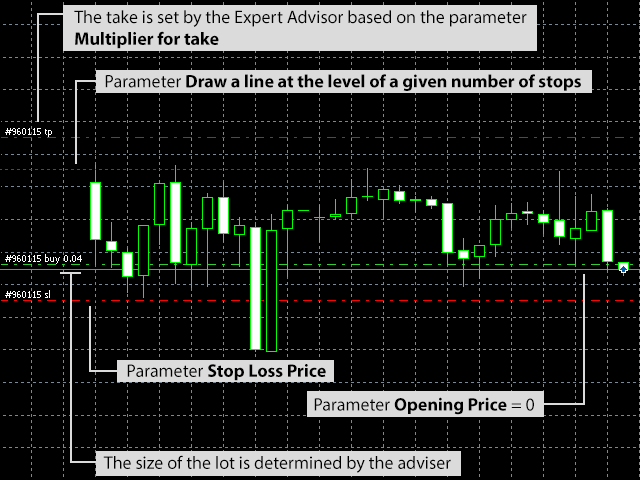The utility helps you to open a trade with a stop loss of no more than the amount you specified, or to abandon the trade altogether. That is, it determines the number of lots for which you need to make a trade, so that the stop loss is as close as possible, but not more than the amount that you specified.
For example, it will be indispensable when trading on the Gerchik strategy. That is, when trading from risks, when you have a fixed risk and a fixed take profit in relation to the stop loss. For example, if you always enter with a risk of $ 10 and a take profit of $ 30 (3 to 1), then this utility will help you easily determine the number of lots that you need to make a trade to meet the conditions.
It also allows you to:
- set the automatic application of the minimum possible stop loss for this symbol;
- set the take profit according to your level in relation to the stop loss (3 to 1, 4 to 1, etc.).);
- open a trade both on the market and by placing a limit order;
- check and do not enter the trade if the take profit goes beyond the boundary price of the channel in which the instrument is located;
- draw a line on the ratio of take profit to stop loss, where you want to make a partial exit from the trade.
The stop loss amount can be specified in dollars or as a percentage of the balance.
[spoiler title=”Read More…”]
You don’t have to open a deal. You can just look at how many lots you need to make a deal and where to put a take profit. This information is displayed in the utility settings window when you set the stop loss price.
Run the utility on the chart where you want to make a trade. You must specify one parameter – the stop loss level (Stop loss Price). That is, the price where the stop loss should be set. This price can be specified either by manually entering it in the appropriate field, or by moving the red line created by the utility on the chart.
Based on the stop loss level and other parameters, the utility will determine which way to make a trade, how many lots it should be, what order it should be made (by market or limit), and where to put a take profit.
- Loss in dollars or per cent for a stop line (STOP_IN) – the amount in dollars or as a percentage of the balance that you agree to risk if a stop loss is triggered (by default, in dollars);
- Choice of dimension for STOP_IN-allows you to choose whether the amount you risk entering the trade is entered in dollars or as a percentage of the balance;
- Do not open a trade if at min lot stop is greater than STOP_IN – if true, the trade will not be opened if at the minimum lot of the instrument the amount of loss at stop loss is greater than the one you are willing to risk (by default, true);
- Opening price (0 – by market) – the price at which to open a trade (if > 0, a limit order will be sent, otherwise-a market order); this price can be specified either manually by entering in the appropriate field, or by moving the green line created on the chart;
- Multiplier for take-the multiplier for determining the take profit in relation to the stop loss (by default, 4, that is, when you reach the take profit, you will earn 4 times more than you could lose with the stop loss);
- Draw a line at the level of a given number of stops – if greater than 0, then the graph will draw a line at a specified multiplier relative to the stop loss (default is 3, that is, a line will be drawn at the level of three stop losses from the opening price in a profitable way); this line can be used to determine the prices on which to close the deal, if you practice a gradual exit from the transaction;
- The price of the top level (0 – do not check) – in this field, you can specify the maximum price above which the take profit should not be (if the take profit exceeds this price, the order will not be created). That is, if the instrument is traded in the channel, and you are 99% sure that the price will not go above the channel level, then you can specify the boundary price of the channel to be sure that with the multiplier you choose, the take profit price will not go beyond the channel.
Demo version:
[/spoiler]





